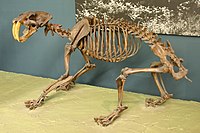
Photo from wikipedia
OBJECTIVES Size-corrected tooth crown measurements were used to estimate phenetic affinities among Homo naledi (~335-236 ka) and 11 other Plio-Pleistocene and recent species. To assess further their efficacy, and identify dental… Click to show full abstract
OBJECTIVES Size-corrected tooth crown measurements were used to estimate phenetic affinities among Homo naledi (~335-236 ka) and 11 other Plio-Pleistocene and recent species. To assess further their efficacy, and identify dental evolutionary trends, the data were then quantitatively coded for phylogenetic analyses. Results from both methods contribute additional characterization of H. naledi relative to other hominins. MATERIALS AND METHODS After division by their geometric mean, scaled mesiodistal and buccolingual dimensions were used in tooth size apportionment analysis to compare H. naledi with Australopithecus africanus, A. afarensis, Paranthropus robustus, P. boisei, H. habilis, H. ergaster, H. erectus, H. heidelbergensis, H. neanderthalensis, H. sapiens, and Pan troglodytes. These data produce equivalently scaled samples unaffected by interspecific size differences. The data were then gap-weighted for Bayesian inference. RESULTS Congruence in interspecific relationships is evident between methods, and with many inferred from earlier systematic studies. However, the present results place H. naledi as a sister taxon to H. habilis, based on a symplesiomorphic pattern of relative tooth size. In the preferred Bayesian phylogram, H. naledi is nested within a clade comprising all Homo species, but it shares some characteristics with australopiths and, particularly, early Homo. DISCUSSION Phylogenetic analyses of relative tooth size yield information about evolutionary dental trends not previously reported in H. naledi and the other hominins. Moreover, with an appropriate model these data recovered plausible evolutionary relationships. Together, the findings support recent study suggesting H. naledi originated long before the geological date of the Dinaledi Chamber, from which the specimens under study were recovered.
Journal Title: American journal of physical anthropology
Year Published: 2021
Link to full text (if available)
Share on Social Media: Sign Up to like & get
recommendations!